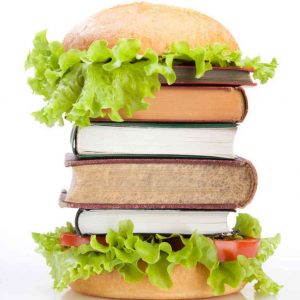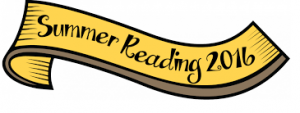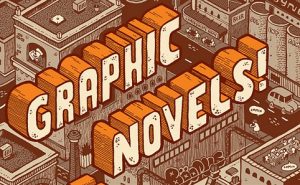Today we share with you a post that first ran in 2016, which has been updated with information for this years’ Peabody Summer Reading. We hope you enjoy exploring the various kinds of reading you can accomplish at the Library this summer!
I think we’ve made the analogy here at some point before, but books are a lot like food. Some formats, genres, styles, etc., are like candy, that you can just keep consuming with nary a thought. Some are like really expensive, decadent cakes that you bring out for special occasions, and some are like bananas, that, frankly, make you gag just thinking about them (I’m using a personal example here. If bananas are your thing, then more power to you. You can have All My Bananas, too).

Furthermore, the way that we ingest stories is as varied and as particular as the way we ingest food. Some people gobble, some people nibble…you get the idea. The point I am trying to make here (other than the fact that I wish it were lunchtime) is that there is no right way or wrong way to get your daily dose of reading.
 In the case of younger readers (and anyone who has Summer Reading to accomplish). Time was when ‘Summer Reading’ was akin to force-feeding, especially for those students who weren’t visual learners, or who read more slowly, or in a way that wasn’t strictly standard. And that experience turned a lot of people off of reading for a very long time, which is truly heartbreaking. Thankfully, now, summer reading lists tend to be much more flexible in terms of students’ choices, as well as much more inclusive of popular titles and more modern themes (incidentally, if you want to see some of these lists, for you or a student near you, you can see them here). And, even better, is that, as we learn more and more about the wonders of the human brain, we are beginning to appreciate more that not everyone absorbs books in the same way.
In the case of younger readers (and anyone who has Summer Reading to accomplish). Time was when ‘Summer Reading’ was akin to force-feeding, especially for those students who weren’t visual learners, or who read more slowly, or in a way that wasn’t strictly standard. And that experience turned a lot of people off of reading for a very long time, which is truly heartbreaking. Thankfully, now, summer reading lists tend to be much more flexible in terms of students’ choices, as well as much more inclusive of popular titles and more modern themes (incidentally, if you want to see some of these lists, for you or a student near you, you can see them here). And, even better, is that, as we learn more and more about the wonders of the human brain, we are beginning to appreciate more that not everyone absorbs books in the same way.
 For example, despite the fact that we live in a world that is increasingly based on visual learning in the form of computers, tablets, and screens, there are still any number of people who are auditory learners, meaning that they remember better after hearing directions or a story or a lecture than they do after reading or watching one. Often, auditory learners have a tough time with summer reading because it is supposed to be an individual, and highly visual exercise that often feels at once very challenging and very boring. For these readers, audiobooks have been a saving grace. Not only to they present books in a way that auditory learners can absorb much better, they offer any number of benefits for all. For example, audiobooks can help readers access stories about their reading level, or in an unfamiliar vernacular–for example, books like Wuthering Heights or Return of the Native that are denser, and tend to feature very rural language and slang that isn’t always easy to comprehend if not spoken out loud. Additionally, I often find that audiobooks allow me to see the humor or subtext in stories that aren’t always readily obvious from the text.
For example, despite the fact that we live in a world that is increasingly based on visual learning in the form of computers, tablets, and screens, there are still any number of people who are auditory learners, meaning that they remember better after hearing directions or a story or a lecture than they do after reading or watching one. Often, auditory learners have a tough time with summer reading because it is supposed to be an individual, and highly visual exercise that often feels at once very challenging and very boring. For these readers, audiobooks have been a saving grace. Not only to they present books in a way that auditory learners can absorb much better, they offer any number of benefits for all. For example, audiobooks can help readers access stories about their reading level, or in an unfamiliar vernacular–for example, books like Wuthering Heights or Return of the Native that are denser, and tend to feature very rural language and slang that isn’t always easy to comprehend if not spoken out loud. Additionally, I often find that audiobooks allow me to see the humor or subtext in stories that aren’t always readily obvious from the text.
Fortunately, the Library not only has plenty of audiobooks on our shelves, we also have access to digital audiobooks via Overdrive (which you can download) and Hoopla (which allows you to stream content). You can chose to read along with the audiobooks, or listen exclusively. Additionally, a number of e-books offer audio narration along with the text (which Amazon has named WhisperSync) so that you can listen and read at the same time.
 For Peabody middle school readers, praise the Heavens, the only requirement for the summer is to read two books. Any books, whatever books make you happy. And this opens up a whole world of potential for readers. For those who aren’t huge fans of traditional books, the Library has a sizable collection of Graphic Novels. These books are just as valid, just as emotionally and intellectually engaging as straightforward novels, and feature a range of plots, genres, and reading levels. It’s also worth noting that, as graphic novels become an increasingly popular genre, we are seeing the rise of picture books for adults, that feature beautiful, vivid, and imaginative illustrations for those of us who might not be graphic novel readers. These books are a great way to start a conversation about visuals in books, and to help readers of different mediums find some common ground.
For Peabody middle school readers, praise the Heavens, the only requirement for the summer is to read two books. Any books, whatever books make you happy. And this opens up a whole world of potential for readers. For those who aren’t huge fans of traditional books, the Library has a sizable collection of Graphic Novels. These books are just as valid, just as emotionally and intellectually engaging as straightforward novels, and feature a range of plots, genres, and reading levels. It’s also worth noting that, as graphic novels become an increasingly popular genre, we are seeing the rise of picture books for adults, that feature beautiful, vivid, and imaginative illustrations for those of us who might not be graphic novel readers. These books are a great way to start a conversation about visuals in books, and to help readers of different mediums find some common ground.
Finally, reading never has to be a solitary pursuit. Check out our great Teen and Children Events calendars to see some of the great programs we have lined up to help you meet your reading goals, whatever those might be.
